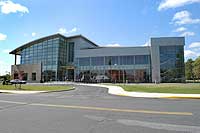Two buildings on the 5,300-acre site of the U.S. Department of Energy's Brookhaven National Laboratory have each been awarded a LEED silver rating by the U.S. Green Building Council. LEED stands for Leadership in Energy and Environmental Design. The two buildings - the 94,500 square-foot Center for Functional Nanomaterials (CFN) and the 65,000 square-foot Research Support Building (RSB) - are the newest on the Brookhaven Lab site.
 Brookhaven's Center for Functional Nanomaterials
Brookhaven's Center for Functional Nanomaterials
The LEED standard has been adopted nationwide by federal agencies, state and local governments, and interested private companies as the industry standard of measurement for green buildings. The LEED green building rating system provides credits for satisfying specified criteria. Projects are evaluated within five categories - sustainable sites, water efficiency, energy and atmosphere, materials and resources, and indoor environmental qualities. Silver is the third-highest certification to be earned, based on points accumulated in these categories.
H.D.R. Architecture, Inc., of Alexandria, Virginia, designed the CFN; Ehasz Giacalone Architects P.C. of Farmingdale, Long Island, designed the RSB; and E.W. Howell Co, Inc., of Woodbury, Long Island, built both buildings. The $42.5-million CFN, which has an additional $25 million worth of high-tech equipment for scientists to explore and develop materials on the nanoscale, was completed in the spring of 2007. Construction of the $13-million RSB, which houses 170 staff who provide support functions for the Laboratory's employees and guests, was finished in the fall of 2006.
Brookhaven Lab's Michael Schaeffer, who was in charge of building the CFN, said, 'LEED certification helps to keeping the planet clean for the next generation. Going green makes sense not only for the environment, but also for ensuring people's comfort.”
Brookhaven's Gregory Flett, who was responsible for the design and construction of the RSB, commented, 'Designing these buildings to achieve the LEED silver rating costs more, but it is worthwhile because sustainable design has many benefits, including lower operating costs, reduced waste going to landfills, conservation of energy and water, reduction of greenhouse gas emissions, and a healthier, safer workplace.”
The sites selected for each building earned green points because they were located in areas that were already partially developed, contained no endangered species, and were not near wetlands. Also, Brookhaven Lab agreed to preserve open space double the size of each building in a wooded, eastern portion of its site for the life of the buildings. Preferred parking is provided for carpool vehicles, and the buildings have changing rooms and showers for those who commute to work by bicycle. Shade trees were planted in the parking area at the CFN, and outdoor lighting is subdued to reduce light pollution.
To gain points in water efficiency, landscaping was planned so that plantings around the buildings require minimum irrigation, and no outdoor sprinklers were installed. Efficient toilets and electronic sensors on faucets helped reduce water use by more than 20 percent compared to the required baseline.
The buildings were designed to ensure low energy and maintenance costs, earning numerous points in the category of energy and atmosphere. Installing an additional six inches of insulation in the exterior walls helped increase energy efficiency by 20 percent in the RSB. Both buildings were connected to the Laboratory's site-wide energy management control system, which monitors and controls heating and cooling, thus saving energy.
Materials and resources were conserved as much as possible during the construction of the buildings. In both buildings, 75 percent of construction waste was recycled or reused. For example, at the RSB site, existing blacktop on the building's site was recycled, and used as the base for the new parking lot. Ten percent of CFN construction materials were made from recycled materials.
To preserve indoor environmental quality, ductwork was kept clean and dry during installation, and each building was flushed with 100 percent of outside air for two weeks prior to occupancy. Ventilation rates are based on carbon-dioxide sensors. Water-based paint and other low volatile organic compound-emitting materials were used in construction. In the RSB, 90 percent of building occupants have a view of the outdoors. Occupancy sensors in all office and circulation areas control efficient lighting, and thermostats are located throughout the buildings, so that occupants can readily control the interior temperature for comfort, within certain limits. Both buildings are no-smoking sites.